ISOSCELES EQUILATERAL AND SCALENE TRIANGLES
Isosceles Triangle :
A triangle is isosceles, if it has at least two congruent sides or two congruent angles.
Equilateral Triangle :
A triangle is equilateral, if all the three sides are congruent or all the three angles are congruent.
Scalene Triangle :
A triangle is scalene triangle, if it has three unequal sides.
Base Angles Theorem
If two sides of a triangle are congruent, then the angles opposite them are congruent.
|
If AB ≅ AC, then ∠B ≅ ∠C |
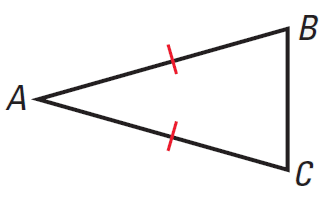 |
Converse of the Base Angles Theorem
If two sides of a triangle are congruent, then the angles opposite them are congruent.
|
If ∠B ≅ ∠C, then AB ≅ AC |
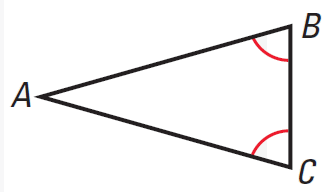 |
Corollaries to the Above Theorems
Corollary (i) :
If a triangle is equilateral, then it is equiangular.
Corollary (ii) :
If a triangle is equiangular, then it is equilateral.
The above two corollaries have been illustrated in the picture given below.
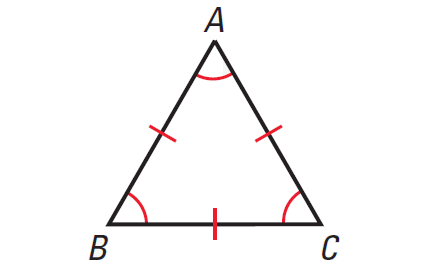
Solving Problems on Isosceles Equilateral and Scalene Triangles
Problem 1 :
Use the diagram of ΔABC shown below to prove the Base Angles Theorem.
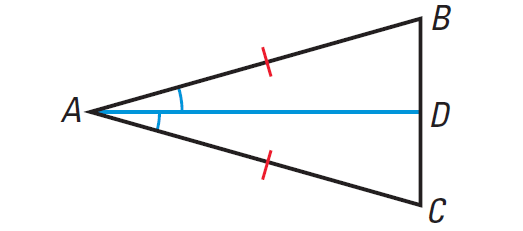
Solution :
Given : In ΔABC, AB ≅ AC.
To prove : ∠B ≅ ∠C.
Proof :
(i) Draw the bisector of ∠CAB.
(ii) By construction, ∠CAD ≅ ∠BAD.
(iii) We are given that AB ≅ AC. Also DA ≅ DA, by the Reflexive Property of Congruence.
(iii) Use the SAS Congruence Postulate to conclude that ΔADB ≅ ΔADC.
(iv) Because corresponding parts of congruent triangles are congruent, it follows that ∠B ≅ ∠C.
Problem 2 :
In the diagram shown below,
(i) find the value of x
(ii) find the value of y
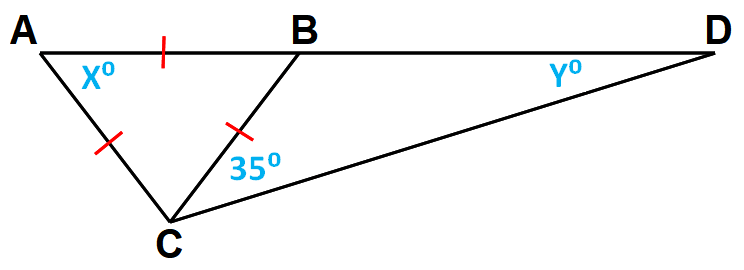
Solution (i) :
In the diagram shown above, x represents the measure of an angle of an equilateral triangle.
From the corollary given above, if a triangle is equilateral, then it is equiangular.
So, the measure of each angle in the equilateral triangle is x.
By the Triangle Sum Theorem, we have
x° + x° + x° = 180°
Simplify.
3x = 180
Divide both sides by 3 to solve for x.
x = 60
Solution (ii) :
In the diagram shown above, the vertex angle forms a linear pair with a 60° angle, so its measure is 120°.
It has been illustrated in the diagram given below.
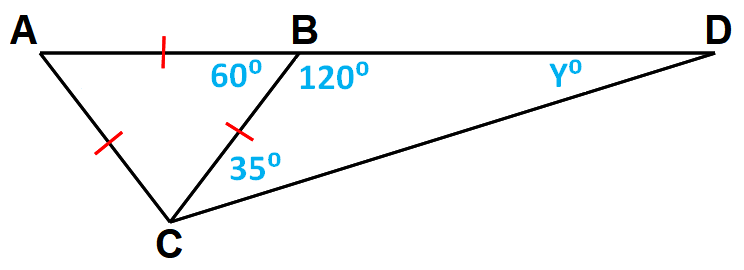
By the Triangle Sum Theorem, we have
120° + 35° + y° = 180°
Simplify.
155° + 2y° = 180°
155 + 2y = 180
Subtract 155 from both sides.
y = 25
Problem 3 :
In the diagram shown below,
(i) find the value of x
(ii) find the value of y
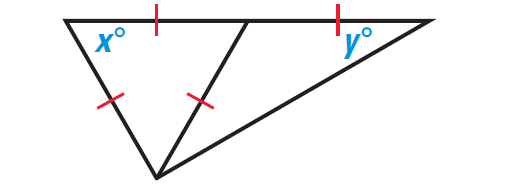
Solution (i) :
In the diagram shown above, x represents the measure of an angle of an equilateral triangle.
From the corollary given above, if a triangle is equilateral, then it is equiangular.
So, the measure of each angle in the equilateral triangle is x.
By the Triangle Sum Theorem, we have
x° + x° + x° = 180°
Simplify.
3x = 180
Divide both sides by 3 to solve for x.
x = 60
Solution (ii) :
In the diagram shown above, y represents the measure of a base angle of an isosceles triangle.
From the Base Angles Theorem, the other base angle has the same measure. The vertex angle forms a linear pair with a 60° angle, so its measure is 120°.
It has been illustrated in the diagram given below.
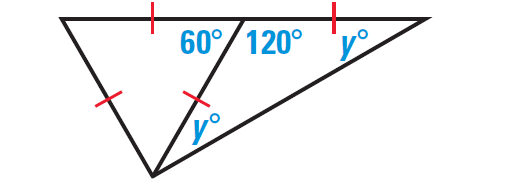
By the Triangle Sum Theorem, we have
120° + y° + y° = 180°
Simplify.
120 + 2y = 180
Subtract 120 from both sides.
2y = 60
Divide both sides by 2.
y = 30
Kindly mail your feedback to v4formath@gmail.com
We always appreciate your feedback.
©All rights reserved. onlinemath4all.com
Recent Articles
-
Trigonometry Pythagorean Identities
May 02, 24 11:43 PM
Trigonometry Pythagorean Identities -
Trigonometry Quotient Identities
May 02, 24 11:08 PM
Trigonometry Quotient Identities -
Unit Rates
May 02, 24 09:27 AM
Unit Rates - Concept - Examples with step by step explanation